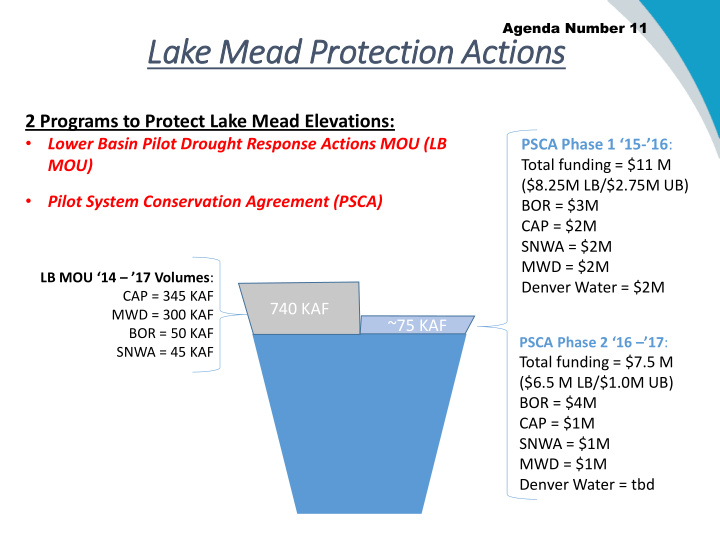



Agenda Number 11 Lake Mead Pro La rotection Actions 2 Programs to Protect Lake Mead Elevations: • Lower Basin Pilot Drought Response Actions MOU (LB PSCA Phase 1 ‘15 - ’16 : MOU) Total funding = $11 M ($8.25M LB/$2.75M UB) • Pilot System Conservation Agreement (PSCA) BOR = $3M CAP = $2M SNWA = $2M MWD = $2M LB MOU ‘14 – ’17 Volumes : Denver Water = $2M CAP = 345 KAF 740 KAF MWD = 300 KAF ~75 KAF BOR = 50 KAF PSCA Phase 2 ‘16 –’17 : SNWA = 45 KAF Total funding = $7.5 M ($6.5 M LB/$1.0M UB) BOR = $4M CAP = $1M SNWA = $1M MWD = $1M Denver Water = tbd
CAP Forbearance Volumes to Support Lake Mead Conservation Efforts Memorandum of Understanding (MOU) Reserv oir Protection Volumes Program 2014 2015 2016 Total Y uma Mesa Irrigation and Drainage District Fallowing 6,827 7,137 7,000 20,964 Ag Forbearance 1 EC-ICS 0 80,922 82,922 163,844 Ag Forbearance 3 0 0 10,627 10,627 Municipal Forbearance - Supply Replacement EC-ICS 0 15,000 16,000 31,000 CAP and On River Turnback 18,290 81,964 18,311 118,565 MOU Program Subtotals 25,117 185,023 134,860 345,000 MOU Program Costs - $ 2,124,000 $ 2,620,000 $ 4,744,000 Pilot System Conserv ation Programs Program 2014 2015 2016 Total Ag Forbearance 2 0 0 25,265 25,265 USBR/Tohono O'odham System Conservation 0 10,080 0 10,080 Pilot Program Subtotals - 10,080 25,265 35,345 Pilot Program Costs* - $ 743,000 $ 1,825,000 $ 2,568,000 * includes additional conservation savings generated above CAP-related programs indicated Reclamation System Conserv ation Program Program 2014 2015 2016 Total Fort McDowell Y avapai Nation System Conservation 0 0 13,933 13,933 Reclamation Program Subtotals - - 13,933 13,933 2014 2015 2016 Total Total Forbearance Target 25,117 195,103 174,058 394,278
Lake Mead Pro rotection Pro rogress • CAP’s MOU target of 345 kaf will be completed by the end of 2016 • BOR and SNWA will have conserved more than 44 kaf of their MOU target by the end of 2016 • CAP with its Lower Basin PSCP partners will have conserved more than 50 kaf by the end of 2016 • The combined efforts will put more than 435 kaf by the end of 2016 or 5.5’ in Lake Mead Mexico has a current balance of about 230,000 acre-feet of conservation storage in Lake Mead – another 3ft 5/16/2016 3
Agenda Number 11 Colorado River Water Supply Report Attachment 1 Total System Contents: 27.48 MAF 73% 5/30/16 Reservoir Capacities (MAF) Reservoir Current Change Maximum 91% Lake Mead 9.52 - 0.26 25.90 Lake Powell 12.08 + 1.10 24.30 Flaming Gorge Reservoir 3.42 + 0.22 3.75 Navajo Reservoir 1.55 + 0.07 1.70 Blue Mesa Reservoir 0.57 0.00 0.83 Fontenelle Reservoir 0.25 + 0.10 0.34 Morrow Point Reservoir 0.10 - 0.01 0.12 Note : Even though Lake 69% Mead is below the Tier 1 Lake Powell shortage elevation, no 3,700’ shortage condition is 50%, 12.08 MAF declared until the USBR 84% August 24 month study 2016 Equalization Level 3,651’ projects an end of year Lake Mead elevation 3,603’ below 1075’. 91% Lake Mead 1,220’ 37%, 9.52 MAF Tier 1 Shortage 1,075’ 1,074’
Agenda Number 11 Attachment 2 Snow Conditions As of 5/31/2016, the current SWE is 4.7 inches. When the current SWE is compared to the historical (1981-2010) median SWE (2.5 inches) for the same date (5/31/2016), the current SWE is at 188% of the historical median SWE. When compared to the historical median for the entire season (14.2 inches), the current SWE is at 33% of the entire season. Probability of Shortage Current modeling results from April 2016 generated by the Bureau of Reclamation show a 10% probability of Colorado River shortage for 2017 and a 56% probability for 2018. The probabilities of shortage for the years after 2018 are above 60%. Probability Probability Probability Probability Year of of Tier 1 of Tier 2 of Tier 3 Lake Powell Inflow Shortage Shortage Shortage Shortage The May 24-month study shows the observed and projected inflow into 2017 10% 10% 0% 0% Lake Powell for Water Year 2016 to be 8.7 MAF. Even though the SWE for this water year tracks with the historical median, unregulated inflow into 2018 56% 56% <1% 0% Lake Powell is below the historical average. This is likely due to the dry conditions in the basin early in the snowmelt season (February-March). 2019 64% 46% 18% <1% The main runoff season that contributes the largest inflow into Lake Powell is during the months of April – July. From the May 24-month study, 2020 64% 40% 18% 6% the 2016 April – July runoff forecast is 77% (5.504 MAF) of the historical average (7.158 MAF). The 2015 runoff season was 94% (6.712 MAF) of the 2021 61% 33% 18% 10% historical average.
Recommend
More recommend